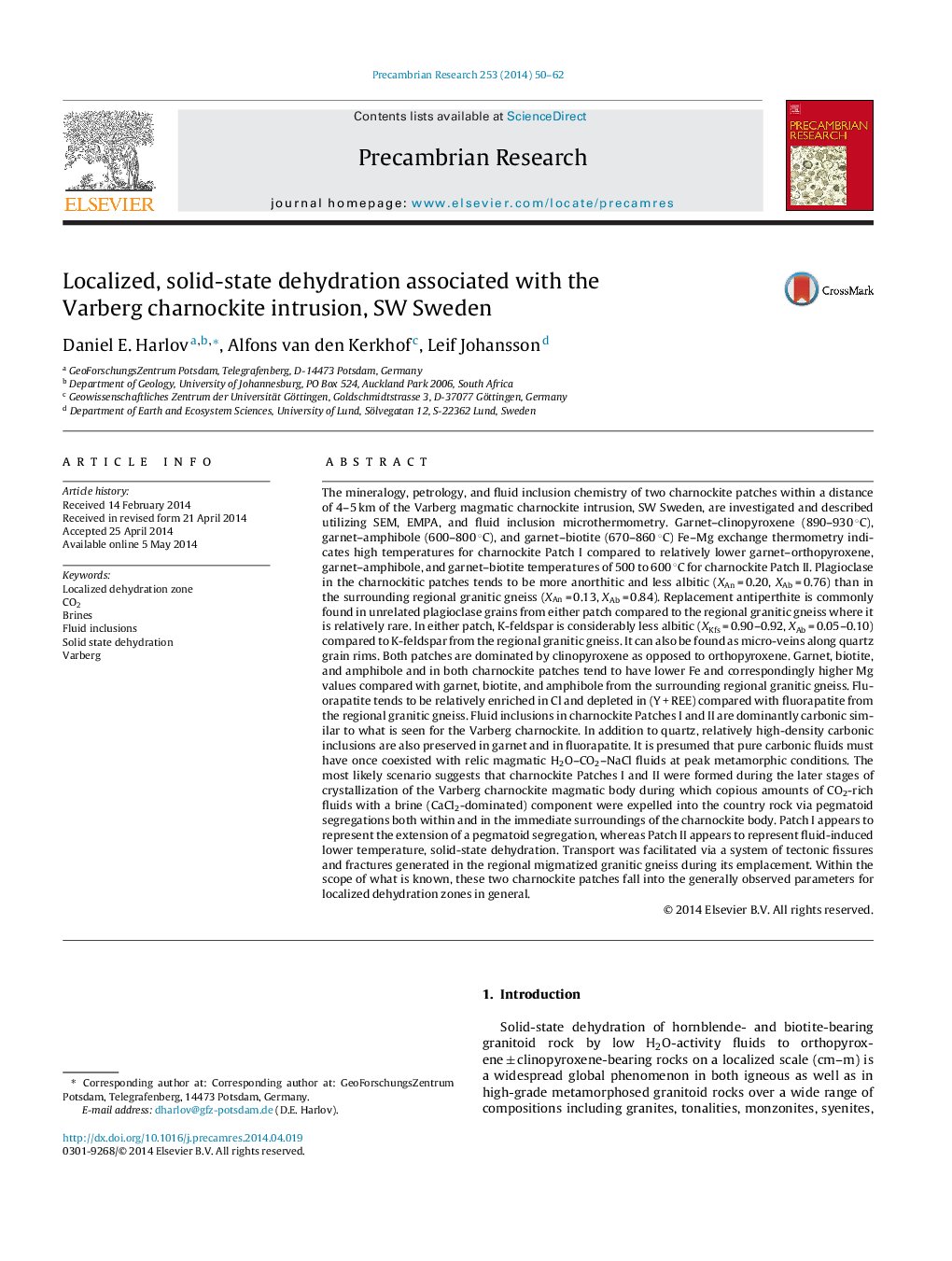| کد مقاله | کد نشریه | سال انتشار | مقاله انگلیسی | نسخه تمام متن |
|---|---|---|---|---|
| 4722931 | 1639621 | 2014 | 13 صفحه PDF | دانلود رایگان |

• Localized orthopyroxene-bearing dehydration zones.
• Varberg–Torpa charnockite–granite association, SW Sweden.
• Fluid induced, in situ conversion of OH-bearing minerals to pyroxenes.
• Role of fluids vs. partial melting.
The mineralogy, petrology, and fluid inclusion chemistry of two charnockite patches within a distance of 4–5 km of the Varberg magmatic charnockite intrusion, SW Sweden, are investigated and described utilizing SEM, EMPA, and fluid inclusion microthermometry. Garnet–clinopyroxene (890–930 °C), garnet–amphibole (600–800 °C), and garnet–biotite (670–860 °C) Fe–Mg exchange thermometry indicates high temperatures for charnockite Patch I compared to relatively lower garnet–orthopyroxene, garnet–amphibole, and garnet–biotite temperatures of 500 to 600 °C for charnockite Patch II. Plagioclase in the charnockitic patches tends to be more anorthitic and less albitic (XAn = 0.20, XAb = 0.76) than in the surrounding regional granitic gneiss (XAn = 0.13, XAb = 0.84). Replacement antiperthite is commonly found in unrelated plagioclase grains from either patch compared to the regional granitic gneiss where it is relatively rare. In either patch, K-feldspar is considerably less albitic (XKfs = 0.90–0.92, XAb = 0.05–0.10) compared to K-feldspar from the regional granitic gneiss. It can also be found as micro-veins along quartz grain rims. Both patches are dominated by clinopyroxene as opposed to orthopyroxene. Garnet, biotite, and amphibole and in both charnockite patches tend to have lower Fe and correspondingly higher Mg values compared with garnet, biotite, and amphibole from the surrounding regional granitic gneiss. Fluorapatite tends to be relatively enriched in Cl and depleted in (Y + REE) compared with fluorapatite from the regional granitic gneiss. Fluid inclusions in charnockite Patches I and II are dominantly carbonic similar to what is seen for the Varberg charnockite. In addition to quartz, relatively high-density carbonic inclusions are also preserved in garnet and in fluorapatite. It is presumed that pure carbonic fluids must have once coexisted with relic magmatic H2O–CO2–NaCl fluids at peak metamorphic conditions. The most likely scenario suggests that charnockite Patches I and II were formed during the later stages of crystallization of the Varberg charnockite magmatic body during which copious amounts of CO2-rich fluids with a brine (CaCl2-dominated) component were expelled into the country rock via pegmatoid segregations both within and in the immediate surroundings of the charnockite body. Patch I appears to represent the extension of a pegmatoid segregation, whereas Patch II appears to represent fluid-induced lower temperature, solid-state dehydration. Transport was facilitated via a system of tectonic fissures and fractures generated in the regional migmatized granitic gneiss during its emplacement. Within the scope of what is known, these two charnockite patches fall into the generally observed parameters for localized dehydration zones in general.
Journal: Precambrian Research - Volume 253, October 2014, Pages 50–62